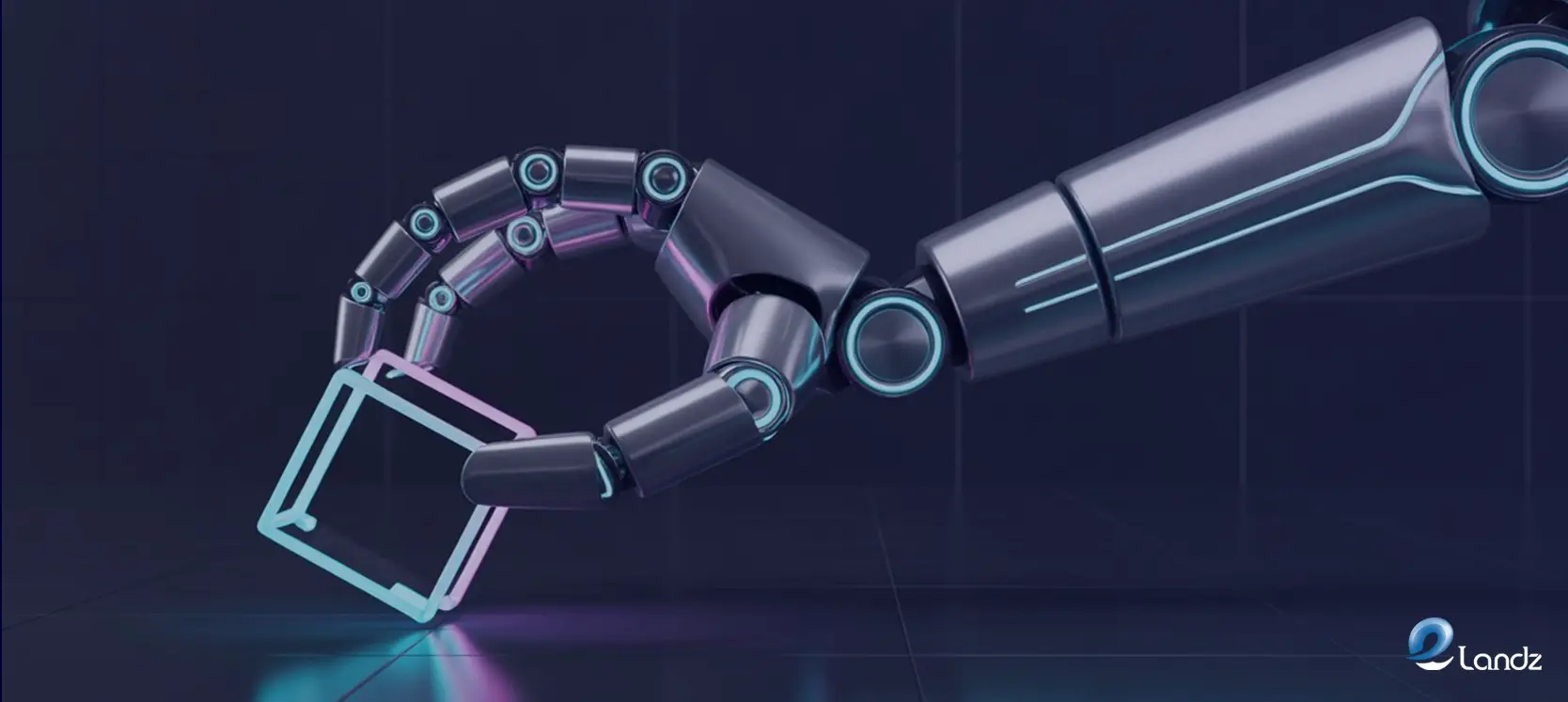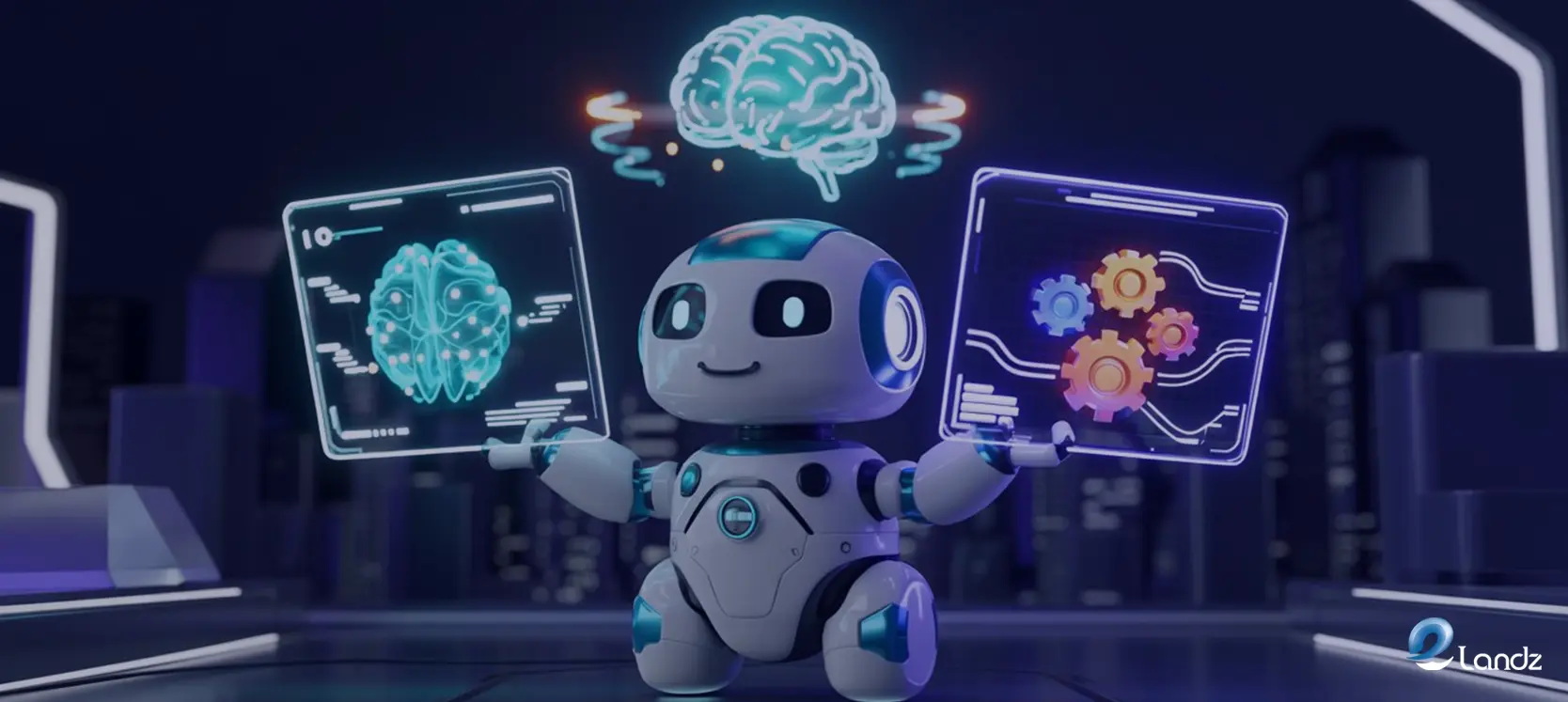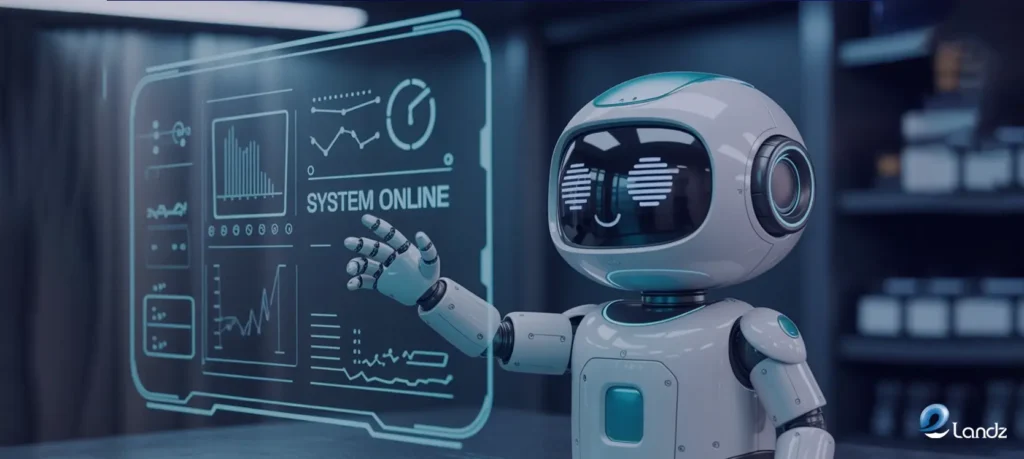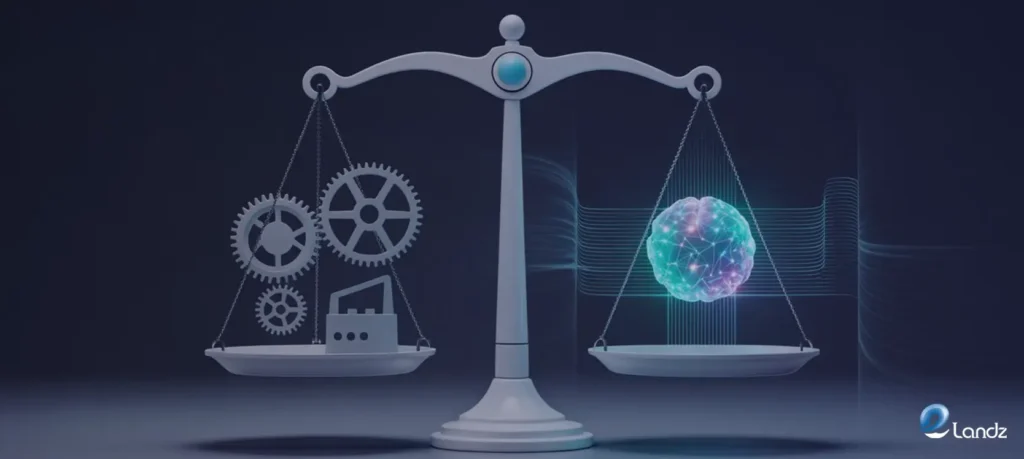
Understanding the Difference Between AI vs Automation
23 Sep 2025Introduction
When people discuss AI versus automation, confusion often arises. Both technologies help businesses work smarter and reduce human error, but they operate in fundamentally different ways. One follows rules blindly, while the other thinks and learns.
Understanding the core differences between AI and automation helps companies choose the right technology for each situation. This guide breaks down the key differences between these technologies and explains why the distinction matters for achieving business success.
What Is Automation?

Automation uses technology to perform tasks with little or no human involvement. Think of a coffee machine programmed to brew at 7 a.m. It doesn’t think or decide anything—it simply follows your preset rules.
The keyword here is “follows.” Automation executes predetermined instructions consistently and reliably, but it cannot adapt or make independent decisions.
How Automation Works
Automation systems operate on “if-then” logic. If a customer makes a purchase, then send a receipt email. If inventory drops below 50 units, then reorder supplies. These rules stay fixed unless someone manually changes them.
A factory robot welding car parts demonstrates classic automation. The robot moves its arm in the same pattern for every car, applying the same pressure and following identical steps. This consistency makes automation perfect for repetitive tasks.
Types of Automation Systems
These are a few types of automation systems.
Rule-Based Automation
The simplest form follows strict instructions without variation. When someone fills out a contact form on your website, the system automatically sends their information to your sales team.
Robotic Process Automation (RPA)
Software robots handle digital tasks that humans used to do manually. They extract data from emails, update spreadsheets, and process invoices without getting tired or making careless mistakes.
Workflow Automation
These systems manage complex processes with multiple steps. An employee expense report may be routed through department managers, accounting, and HR for final approval.
The History Behind Automation
Automation started centuries ago with simple mechanical devices. Water wheels ground grain automatically in ancient times. The Industrial Revolution brought steam-powered machines that could produce goods faster than human workers.
Assembly lines revolutionized manufacturing in the early 1900s. Henry Ford’s car production system showed how automation could transform entire industries. By the mid-20th century, electronic systems handled increasingly complex processes.
Today’s automation runs on sophisticated software and hardware. Companies automate everything from customer emails to financial reporting, but the core principle remains the same: follow predetermined rules consistently.
Understanding Artificial Intelligence

Artificial intelligence creates systems that mimic human thinking processes. Instead of just following rules, AI analyzes information, recognizes patterns, and makes decisions based on what it learns.
The crucial difference is learning. While automation repeats the same actions forever, AI improves its performance over time by studying new data and experiences.
How AI Thinks and Learns
AI systems study massive amounts of data to identify patterns that humans might miss. A fraud detection system analyzes millions of transactions to recognize suspicious behavior. As it encounters new fraud attempts, the system learns to spot similar patterns in the future.
This learning capability distinguishes AI from traditional automation. An email spam filter powered by AI gets better at blocking unwanted messages as it processes more examples. It adapts to new spam techniques without human programming.
Key AI Technologies
Let’s take a look.
Machine Learning
Algorithms that improve their performance by studying data patterns. Netflix’s recommendation engine learns your viewing preferences and suggests shows you might enjoy based on similar users’ behavior.
Natural Language Processing
AI systems that understand and generate human language. Virtual assistants like Alexa interpret spoken commands and respond conversationally, not just with scripted responses.
Computer Vision
AI analyzes images and videos to identify objects, people, or unusual patterns. Security cameras can automatically detect intruders or recognize specific individuals without human monitoring.
Deep Learning
Advanced neural networks process enormous amounts of data to solve complex problems. These systems power language translation, medical diagnosis, and autonomous vehicle navigation.
Current AI Limitations
Today’s AI specializes in narrow tasks rather than general intelligence. A chess-playing AI cannot drive cars or write poetry. Each system focuses on specific domains where it excels.
This “narrow AI” performs incredibly well within its specialty but struggles outside those boundaries. The dream of general AI that matches human intelligence across all areas remains theoretical.
Most business AI applications solve specific problems very effectively but require human oversight for broader decision-making contexts.
Core Differences: AI vs Automation
The fundamental distinction between AI and automation lies in their approach to problem-solving and adaptability. Understanding these differences helps businesses choose the right tool for each situation.
Purpose and Capability
Automation executes tasks reliably and consistently. It’s like having a perfectly disciplined employee who follows instructions exactly the same way every time.
AI goes beyond execution to include analysis, learning, and decision-making. It acts more like a consultant who studies information and provides recommendations based on discovered patterns and insights.
Adaptability to Change
Traditional automation systems follow rigid rules. When conditions change, someone must manually update the programming. A scheduling system might continue booking appointments during a holiday weekend unless specifically programmed otherwise.
AI systems adapt to new information automatically. An email spam filter learns to recognize new types of unwanted messages without manual updates. The system evolves its performance through experience with different examples.
Decision-Making Process
Automation makes no real decisions—it follows predetermined paths. When faced with unexpected situations, automated systems either fail or handle them incorrectly because they cannot reason through new scenarios.
AI evaluates situations and chooses appropriate responses based on learned patterns. A customer service chatbot powered by AI can understand the emotional tone of messages and adjust its responses accordingly, while a basic automated chatbot only provides scripted answers.
Learning and Improvement
Automation systems require manual updates to improve their performance. If you want to change how an automated email marketing campaign works, someone must reprogram the rules and workflows.
AI systems learn and improve independently. A recommendation algorithm gets better at suggesting relevant products as it processes more customer data and feedback, requiring no manual intervention to enhance its performance.
Technology Requirements
Simple automation can work with basic mechanical or software systems. A timer-controlled irrigation system uses minimal technology but still counts as effective automation.
AI demands significant computing power and large datasets. Machine learning algorithms need examples to learn from and processing power to identify complex patterns in vast amounts of information.
How AI and Automation Complement Each Other
The most powerful business solutions combine both technologies rather than choosing one over the other. This partnership, called intelligent automation, brings together automation’s reliability with AI’s adaptability.
Real-World Integration Examples
Enhanced Customer Service A traditional chatbot follows scripts to answer frequently asked questions. Adding AI helps the system understand customer emotions, interpret complex requests, and provide more personalized responses while still automating the basic interaction flow.
Smart Supply Chain Management Automation manages inventory tracking and reorder processes. AI analyzes demand patterns, weather data, seasonal trends, and market conditions to predict optimal stock levels and prevent both shortages and overstock situations.
Intelligent Financial Processing Automated systems handle routine transactions like payroll processing and invoice approvals. AI monitors these transactions for unusual patterns that might indicate fraud, errors, or optimization opportunities.
Advanced Manufacturing Quality Control Automation controls production line machinery and assembly processes. AI-powered computer vision systems inspect products for defects, learn to recognize new types of quality issues, and automatically adjust production parameters.
The Evolution to Agentic AI
The newest development combines AI reasoning with autonomous action capabilities. Agentic AI systems can understand high-level goals, create detailed plans, and execute complex workflows with minimal human input.
For example, an employee might tell an AI agent to “prepare for the quarterly board meeting.” The agent interprets this request, determines what materials are needed, gathers relevant data, creates presentation slides, schedules meeting rooms, and sends calendar invites! (automatically)
This represents a significant leap beyond traditional automation or basic AI. The system reasons through problems and takes independent action to achieve desired outcomes rather than just following pre-written instructions.
Industry Applications of AI vs Automation

Different industries use AI and automation in distinct ways, highlighting the importance of understanding when each technology provides the greatest value.
Manufacturing and Production
Traditional automation excels at repetitive assembly tasks, material handling, and quality control processes that require consistent execution. Robotic arms weld car parts with perfect precision, and conveyor systems move products through assembly lines efficiently.
AI enhances these automated processes by predicting equipment maintenance needs, optimizing production schedules based on demand forecasts, and identifying quality issues that standard sensors might miss.
Healthcare and Medical Services
Automation handles routine administrative tasks like appointment scheduling, prescription refills, and insurance claims processing. These systems reduce paperwork and ensure consistent data entry across medical records.
AI analyzes medical images to detect diseases, reviews patient histories to suggest treatment options, and monitors vital signs to predict health complications before they become critical.
Financial Services and Banking
Banking automation processes routine transactions, account transfers, and loan applications according to predetermined criteria. ATMs represent classic automation—they dispense cash following exact instructions without human intervention.
AI detects fraudulent transactions by recognizing unusual spending patterns, assesses loan risks by analyzing complex financial data, and provides personalized investment advice based on individual customer profiles and market conditions.
Retail and E-commerce
Automation manages inventory levels, processes orders, and sends shipping notifications. These systems ensure that routine business operations continue smoothly without manual intervention.
AI personalizes shopping recommendations, optimizes pricing strategies based on demand patterns, and predicts which products customers will want before they even search for them.
Human Resources Management
HR automation handles employee onboarding paperwork, benefit enrollments, and payroll processing. These systems ensure compliance with regulations and reduce administrative workload.
AI analyzes resumes to identify qualified candidates, predicts which employees might leave the company, and recommends personalized training programs based on individual career goals and performance data.
Choosing Between AI and Automation
The decision between AI and automation depends on the specific business problem you’re trying to solve. Each technology serves different purposes and provides distinct advantages.
When to Choose Automation
Select automation for tasks that involve consistent, repetitive processes with clear rules. These situations benefit from reliable execution without variation or interpretation.
High-volume data entry, routine email responses, scheduled report generation, and standard approval workflows work well with traditional automation. The predictability of these tasks matches automation’s strength in consistent execution.
Cost considerations also favor automation for simple processes. Basic automated systems require less investment and maintenance than AI solutions while delivering reliable results for straightforward tasks.
When to Choose AI
Choose AI for tasks that require analysis, pattern recognition, or adaptation to changing conditions. These situations benefit from intelligent decision-making and continuous learning capabilities.
Customer behavior analysis, fraud detection, personalized recommendations, and predictive maintenance work better with AI systems. The complexity and variability of these tasks require the flexibility that AI provides.
Long-term value considerations favor AI for complex processes. While initial implementation costs may be higher, AI systems improve their performance over time and handle increasingly sophisticated challenges.
When to Combine Both Technologies
The most powerful solutions often combine AI and automation in intelligent systems that handle both routine execution and complex decision-making. This approach maximizes the benefits of each technology.
Customer service platforms that use automation for basic inquiries and AI for complex problem-solving provide faster response times and better customer satisfaction than either technology alone.
Supply chain systems that automate routine ordering while using AI for demand forecasting and risk management deliver both operational efficiency and strategic advantages.
Implementation Strategies for Business Success
Successfully adopting AI and automation requires careful planning, realistic expectations, and strategic thinking about long-term business goals.
Assessment and Planning Phase
Start by mapping your current business processes to identify specific problems rather than focusing on trendy technologies. Look for bottlenecks, repetitive tasks, and areas where human error commonly occurs.
Distinguish between processes that need consistent execution versus those requiring intelligent decision-making. This analysis guides whether automation, AI, or a combination provides the best solution.
Consider your organization’s technical capabilities and available resources. Simple automation projects might make sense for companies new to these technologies, while experienced teams can tackle more complex AI implementations.
Technology Selection Criteria
Evaluate whether to build custom systems or purchase existing solutions. Most companies benefit from proven platforms that integrate with existing business systems rather than developing everything from scratch.
Look for scalable solutions that can grow with your business needs. Starting small with pilot projects allows for learning and refinement before making major technology investments.
Prioritize systems that offer clear measurement capabilities. You need to track performance improvements, cost savings, and user satisfaction to justify continued investment and expansion.
Change Management Considerations
Prepare employees for changing roles as technology handles routine tasks. Focus training on skills that complement automated systems rather than compete with them.
Communicate clearly about how technology changes will improve working conditions and create new opportunities for professional growth rather than eliminating jobs.
Address concerns directly through transparent communication and comprehensive retraining programs. Employee buy-in significantly impacts implementation success.
AI vs Automation Results

Different metrics matter when evaluating AI versus automation implementations. Understanding these distinctions helps set appropriate expectations and measure actual business impact.
Automation Success Metrics
Measure automation success through efficiency gains, error reduction, and cost savings. Track how much time employees save on routine tasks and how many fewer mistakes occur in automated processes.
Processing speed improvements provide clear automation benefits. Compare how quickly automated systems complete tasks versus manual methods to quantify productivity gains.
Consistency metrics matter for automation evaluation. Measure how reliably automated systems perform tasks the same way every time, reducing variability in business processes.
AI Success Metrics
Evaluate AI systems through accuracy improvements, learning progression, and decision quality. Track how well AI predictions match actual outcomes and how performance improves over time.
Adaptation capabilities distinguish AI from automation. Measure how effectively AI systems handle new situations and learn from experience without manual intervention.
Business impact metrics for AI include revenue growth from better recommendations, cost savings from improved predictions, and customer satisfaction from personalized experiences.
Future Trends in AI vs Automation
The landscape continues evolving rapidly as both technologies become more sophisticated and accessible to businesses of all sizes.
Advancing Automation Capabilities
Automation systems become more intelligent without requiring full AI implementation. Smart automation handles more complex decision trees and exception handling while maintaining the reliability that makes automation valuable.
Integration capabilities expand as automation platforms connect more easily with existing business systems. This reduces implementation complexity and makes automation accessible to smaller organizations.
Expanding AI Applications
AI becomes more accessible through user-friendly interfaces that require less technical expertise. Natural language commands allow business users to interact with AI systems without learning complex programming languages.
Smaller AI models deliver powerful capabilities without requiring massive computing resources. This democratizes AI access for companies that previously couldn’t afford enterprise-level implementations.
Convergence and Integration
The line between AI and automation continues to blur as intelligent automation becomes standard rather than exceptional. Future business systems will seamlessly combine both technologies without users needing to distinguish between them.
Platform approaches integrate AI and automation capabilities in unified solutions that adapt their approach based on task requirements. This reduces complexity while maximizing the benefits of each technology.
Making the Right Choice for Your Business
The question isn’t whether to choose AI or automation, It’s understanding when each technology provides the greatest value and how they work together to solve business problems.
Start with clear business objectives rather than technology preferences. Identify specific problems that need solving, then select tools that address those challenges most effectively.
The most successful companies use both AI and automation strategically, applying each technology where it provides the greatest advantage. Companies that master this combination will work smarter and adapt more quickly to changing market conditions.
FAQs
Check out this FAQ section!
Can automation work without AI?
Yes, automation can function completely independently of AI. Traditional automation systems follow predetermined rules and execute repetitive tasks without requiring any artificial intelligence. Examples include automatic email responses, scheduled backups, and assembly line machinery. These systems rely on simple “if-then” logic rather than learning algorithms.
What are some examples of AI in business?
AI powers recommendation engines like Netflix’s movie suggestions, fraud detection systems in banking, predictive maintenance in manufacturing, and personalized marketing campaigns. Virtual assistants, image recognition software, and language translation tools also represent common AI applications that learn and improve over time.
What is the main difference between AI vs automation?
The fundamental difference lies in learning and adaptability. Automation executes predefined tasks consistently following fixed rules, while AI analyzes data, recognizes patterns, and makes decisions that improve over time. Automation performs the same actions repeatedly, but AI adapts its responses based on new information and experience.
How do AI and automation work together in business?
AI and automation combine to create intelligent systems that handle both routine execution and complex decision-making. For example, an e-commerce platform might use automation to process orders while AI personalizes product recommendations. This combination delivers greater efficiency than either technology alone.
Which technology should my business implement first?
Start with automation for clearly defined, repetitive processes where consistency matters most. Once you’ve mastered basic automation, consider adding AI capabilities for tasks requiring analysis, prediction, or personalization. This progressive approach builds technical expertise while delivering immediate value from simpler implementations.


